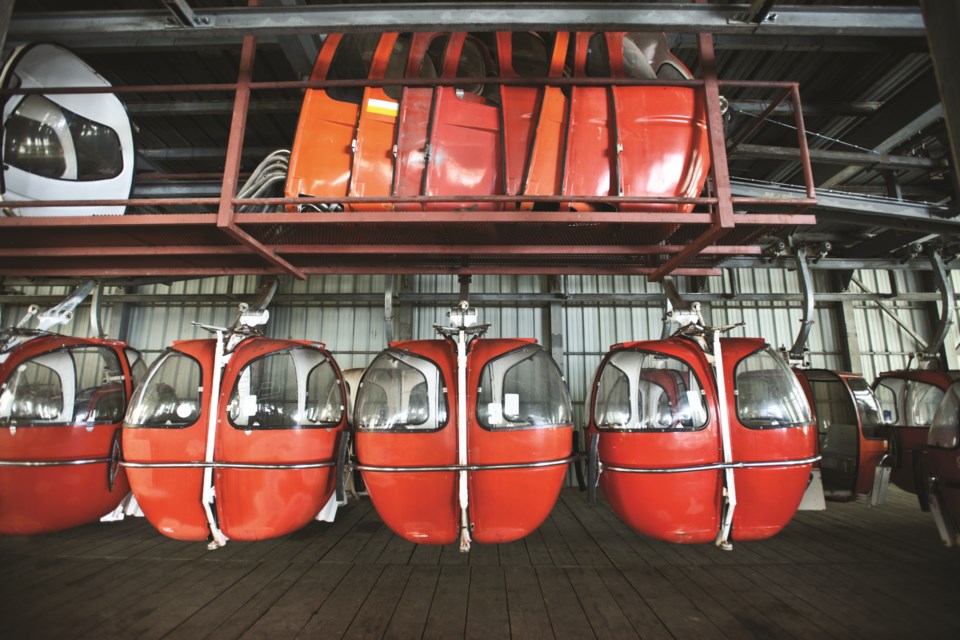With the waning crowds of spring, I’ve been getting a lot of skiing in lately, pounding in runs where I’ll sling myself off a chair, point ’em down, and 500 vertical metres later ski right back onto the same chair. It’s not my usual modus operandi, but both the Zen and efficiency of getting 3,000 vertical metres underfoot in an hour suddenly appeals to me. And while riding those chairs I’ve had a few thoughts about the current state of the sport. One of which seems particularly relevant: I, we—the entire resort world—owes it all to detachable lifts. And that goes back—as does so much in skiing—to a visionary Austrian.
In the tiny province of Vorarlberg, tucked into the folds of the geologic skirt forming Austria’s intersection with Germany, Switzerland, Italy and Lichtenstein, lies the slumbering hamlet of Mellau, population 1,300, altitude 700 metres. A softly contoured mountain municipality which, following its own mealy marketing words, is at best suitable for a low-octane family vacation. Still, this is the Austrian Alps, and so Mellau can be expected to serve up both the comforts of a modern ski vacation as well as all the traditional and historic soft-pursuit strudel you can handle; a syntactical nightmare of a website might even gush that “it” hasn’t lost any of “his” urspruenglichkeit, a cheery-sounding epithet that is roughly translated as “primitiveness.” Not that it matters, because mediocre Mellau has something else going for it. While a resort map plots out lift-served terrain that isn’t always a challenge, it also reveals something else: a short, straight line reaching from village to alpine plateau. The very vector upon which, in 1972, a certain Artur Doppelmayr erected the world’s first detachable lift,** the Rosstelle gondola, a development that revolutionized resort skiing.
In the case of the Doppelmayrs—a family who traces design and innovation roots to 1892, when paterfamilias Konrad Doppelmayr acquired the machine workshop which had apprenticed him in Wolfurt-Rickenbach—it’s more correct to say “a development that further revolutionized resort skiing.” Not only was a circulating mono-cable ropeway with detachable units a stress-reducing boon that gave skiers more time to get on and off as well as faster delivery to their favourite lines, but this cornerstone of modern resorts actually came mid-stride in a brilliant genealogy of spectacular achievement: in 1912, Konrad had produced the world’s first lifting device—a freight elevator—under his own name; in 1937, with engineer Sepp Bildstein, his son Emil constructed the first-ever dedicated ski lift—a T-bar—in Zürs, Arlberg; Artur joined the firm’s ranks in 1955, and by 1972 had designed and built the Rosstelle.
It was a watershed. On and on under Artur’s direction went the engineering firsts: a self-loading T-bar, avalanche-blasting cable lift, detachable triple chair, 12-passenger mono-cable gondola, funicular railway, six-seat express chairlift, 80-passenger large-cabin aerial tram, eight-seat express chairlift, and the first heated chair—where the bench is rewarmed each time the chair cycles through the lower station—that went into operation in 2004 under then director Michael Doppelmayr. By 2019, the Doppelmayr Garaventa Group (the family absorbed the latter rival in 2002) had produced some 15,000 lifts in 96 countries.
Where other early builders had focused on the gigantic and the you’ve-got-to-be-frickin’-kidding-me one-upmanship that characterizes many of Europe’s classic lifts (indeed some companies were struck simply for the purpose of building one spectacular project), family Doppelmayr quietly kept its sights on the make-it-easier ball, iterating this mantra through a range of systems that increased transport speed and reduced waiting times at the base. While others cast their cables against seemingly impossible rock and ice barriers, Doppelmayr threw itself against the barriers of entry to the sport—comfort and convenience. After breathless descent and a line-up to crowd into the terminal, riding up the mountain should become “a moment of repose” goes the corporate philosophy. Most skiers seem to agree: we’ll take convenience over wetting our pants in an ancient, creaking, stretched-cable tram any day.
This thinking was clearly evident in the original detachable, Mellau’s Rosstelle. Until then, lift speed was dictated—and severely limited—by the speed of passenger embarking and debarking. Uncoupling these processes was a stroke of brilliance that allowed leisurely loading/unloading to bookend a high-speed slingshot up the mountain. As a result, the contemporary Doppelmayr clan can ski the world’s resorts with legitimate pride. Their father’s, grandfather’s and great grandfather’s legacy doesn’t proscribe a biggest and craziest continuum, but thousands of diligently cycling threads sewing together the many-panelled quilt of the modern ski world.
If there seems no limit to the innovation the company is willing to bring to the lift game, it’s because there probably isn’t. “I want to build the first ropeway on the moon,” Michael Doppelmayr famously said in a 2006 interview, “I have already secured myself the plots of land, together with the base and mountain terminals.”
You expect he was kidding, of course, but then Konrad, Emil and Artur had set their sights on some fairly weightless engineering feats. Like the idea of a detachable lift—as distant from the orthodoxy of the time as the moon.
Leslie Anthony is a Whistler-based author, editor, biologist and bon vivant who has never met a mountain he didn’t like.
**Editor's note: While not high-speed and not automated, Whistler's first detachable gondola was in fact installed in Creekside in 1965.




